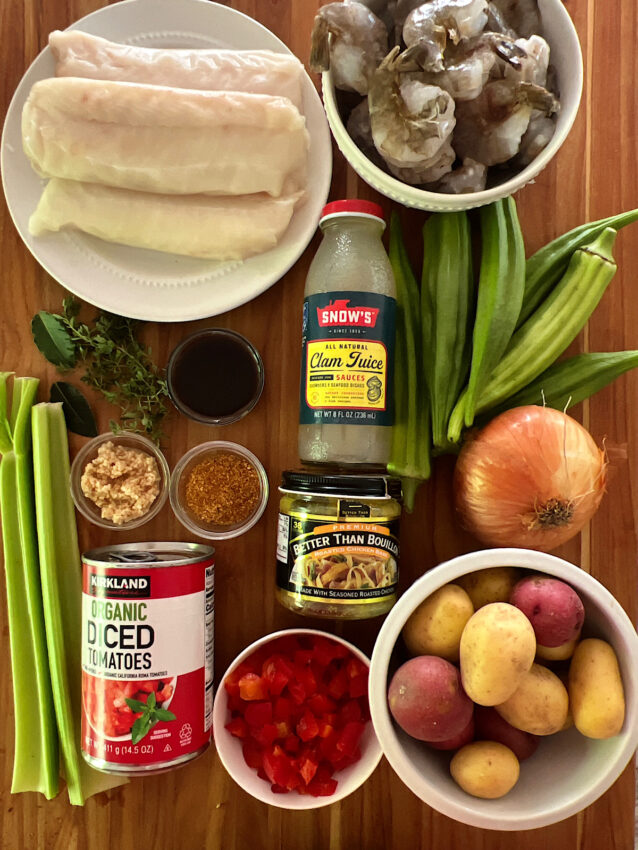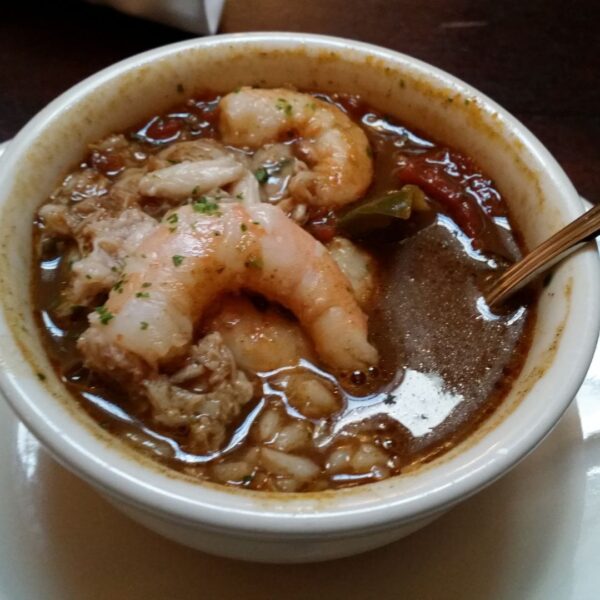Okra is quintessentially Southern and you most often hear of it being used in a gumbo. We grew okra in our Minnesota garden this year, and used it instead of filé powder to thicken our gumbo recipe.
There are many versions of gumbo, and the authentic version is hotly debated. This recipe is from my Southern mama who grew up in Shreveport, Louisiana.

Jump to: RECIPE | Cajun vs Creole | Ingredients and Substitutions | How to Thicken | Cooking with Okra | Common Questions
This post may contain affiliate links. As an Amazon Associate, I also earn from qualifying purchases. You can read our disclosure information here–
What is Gumbo?
The term ”gumbo” comes from an African word for okra, and classic Louisiana gumbos typically include okra. Okra is a delicious pod that adds flavor but also helps to thicken the soup.
Gumbo is a hearty stew that’s served hot over rice. The combination of meats and seafood used in gumbos has many variations, but gumbos always include the trinity (onions, bell peppers, and celery), a Cajun or creole spice blend, and either a roux or okra or a filé powder to thicken it.
Gumbo is a symbol of Louisiana cuisine, but its origins are varied, and its history is complex. My mom is from Shreveport, Louisiana, and had her own opinions on history and how traditional gumbo should be made.
I will leave it to the Gregory restaurant and their detailed post on Cajun and Creole cuisine however to explain the history, as it varies from my mom’s version of course.
Cajun vs Creole Gumbo
Generally speaking, Creole cuisine often uses tomatoes, while Cajun food does not. The spice blend used in creole and cajun gumbos also differs a bit. Creole versions use more paprika and will also often include a handful of other ingredients, such as sweet basil, celery seed, and white pepper.
I will just say that Cajun and Creole gumbos typically share the combination of a roux and a sautéed trinity (onions, bell peppers, and celery) as the base of most Creole and Cajun stews and gumbos.
Ingredients and Substitutions
Although a gumbo can contain any combination of seafood or various meats, the recipe below is for seafood gumbo made with shrimp and white fish. This is the way my Louisiana-bred mom made her gumbo, so I’m sticking to it.
Below are some alternatives and substitutions for the classic ingredients:

Best Proteins for a Louisiana Gumbo
For a seafood gumbo, you can use any combination of fish and shellfish, but shrimp is essential to a classic gumbo. Chicken, sausage or ham is often added. Here are some substitutions that you can mix and match.
- Smoked ham
- Crayfish
- Chicken
- Crab
- Oysters
- Whitefish (halibut, cod, etc.)
What is the Cajun Trinity?
You’ll hear lots of Louisiana cooks talking about the “trinity.” They’re not talking theology.
In Shreveport Louisiana, where my mother is from, the trinity means onions, green bell peppers, and celery, and these are the basic ingredients to lots of traditional Cajun dishes.
How to Get a “Smoky” Flavor in Gumbo
Many cooks think a “good” gumbo should always have a mild smoky flavor. Often this smoky flavor comes from smoked ham.
If you don’t want to add smoked ham to your gumbo, you can get the smoky flavor by adding smoked chile powders.
The amount of heat from a cajun spice blend is highly variable. I have provided my favorite DIY cajun spice blend recipe in the recipe notes below.
I consider the cajun spice blend in this recipe to be medium hot, but it does use cayenne peppers, which some people find to be extremely hot. This is an area where your heat preference comes into play.

Filé powder vs Roux vs Okra
The way that Louisiana gumbo is thickened is, in large part, what distinguishes it from other stew or soups. There are 3 ways to thicken gumbo: a filé powder, a roux or with okra. Here’s a summary of each.
Filé powder:
Many traditional Louisiana gumbo recipes use a filé powder to thicken the soup. Filé powder is made up of ground sassafras leaves and when used in gumbos it is frequently mixed with cream and parsley.
Filé powder works as a thickener by whisking in a tablespoon at the very last minute, after you’ve taken the soup off the heat.
Filé powder Gives gumbo a distinctive, pine-like flavor, but it can be difficult to find in many grocery stores.

Dark roux:
The roux used in gumbo is quite different from the roux used in classic French cuisine. Louisiana gumbo roux is a mixture of flour and some kind of fat (often bacon fat), but it is cooked much longer than French roux.
The color of the gumbo roux depends on how long it is cooked. It ranges anywhere from light brown to brownish-red to almost black. The longer it is cooked, the darker and nuttier it becomes. It does, however, become thinner as the cooking time and darkening increase.
When using a roux in seafood gumbos, you will usually see the darker roux. This darker roux has the most flavor but is also the thinnest.
A dark roux can take up to 40 minutes of constant stirring, so it is more labor-intensive than the other methods of thickening.
The deeply colored brown roux is often used in gumbos that include ham. A heavily smoked ham (tasso in New Orleans) adds a lightly thickened, smoky base which can be further thickened with the addition of okra.

Okra:
Okra (usually chopped) is a classic gumbo ingredient, giving it a special texture and body. Okra is relatively easy to find (you can use frozen) and it gives a different texture to the soup than a roux.
Okra has the distinctive reputation of being slimy, and while this sounds negative, okra is a key ingredient for most seafood gumbos. While a slimy texture is not desirable for a side dish of sautéed okra, its signature texture is what helps thicken the gumbo.
If you try to cook the slime out before adding it to the gumbo, it doesn’t work, as the okra releases its “mucilage” even after cooking it first.

Tips to help okra be less slimy:
- Cooking it at high heat before adding to the gumbo.
- Make sure the okra is completely dry before cooking it.
- The liquid that makes okra feel slimy comes out when you cut the okra, so try to limit how much you cut the vegetable.
- You can try poking holes in the top of the pod right beneath the stem and let some of the mucilage out. Then chop the okra the way you want it.
- Use frozen okra and cut it up while still frozen.
- Soak in vinegar 1/2 hour before cooking; rinse and pat dry.
- Embrace the slime and view it as a nutritious gumbo thickener.
Combination thickeners:
Normally gumbo is thickened by roux and okra, or roux and filé powder. Okra and filé powder rarely appear together.
Common Questions
How to store and/or freeze?
Gumbo can be made a day or two ahead of time and kept in the refrigerator. It will keep frozen for a month. If your gumbo is fairly thick you can add water when reheating the frozen version.
How to serve?
The traditional way to serve gumbo is over rice. For plating it in the classic New Orleans way, fill a cup with rice, and invert the cup into a wide soup bowl. When you remove the cup you have a mound of rice and the gumbo is then ladeled around the rice.
Favorite Stews Similar to Seafood Gumbo

Like this recipe? It helps me out greatly if you leave a 5-star 🌟🌟🌟🌟🌟rating in the recipe card below and maybe even leave me a quick comment too!
Creole Seafood Gumbo
Equipment
- Dutch oven Or large heavy pot
Ingredients
- 2 tablespoons olive oil
- 1 onion chopped
- 1 large bell pepper can be green or red; chopped
- 2 stalks celery chopped
- 3 cloves garlic minced
- 14 ounces can of tomatoes
- 1 pound fingerling potatoes or large potatoes cur into bite-size pieces
- 1 Cup sliced okra
- 4 Cups chicken stock
- 1 cup clam juice
- 2 bay leaves
- 5 sprigs fresh thyme
- 1 tablespoon creole seasoning blend or to taste, depending on heat in blend
- 2 tablespoons worcestershire sauce
- 1 ½ pounds cod cut into 1-2 inch chunks
- 1 pound raw shrimp with shells on
- parsley and hot sauce for the table
Instructions
- The creole/cajun trinity: In a dutch over or large pot heat the oil over medium-high heat.Saute the onion, pepper and celery in oil until softened (about 5-7 minutes). Add garlic and cook another 30 seconds.2 tablespoons olive oil, 1 onion, 1 large bell pepper, 2 stalks celery, 3 cloves garlic
- Add the tomatoes, potatoes and okra to the pot and stir. Add the chicken broth, clam juice, herbs and seasoning blend to the pot. Cover and simmer over medium-low heat for 30 minutes.14 ounces can of tomatoes, 1 pound fingerling potatoes, 1 Cup sliced okra, 4 Cups chicken stock, 1 cup clam juice, 2 bay leaves, 5 sprigs fresh thyme, 1 tablespoon creole seasoning blend, 2 tablespoons worcestershire sauce
- Uncover the pot and add the cod and the shrimp. Cook, uncovered until shrimp is pink (about 4-5 minutes.1 1/2 pounds cod, 1 pound raw shrimp
- Serve with parsley and hot sauce on the table. If you want rice, a classic way to serve is to mound the rice in the middle of the bowl and ladle the gumbo around it.
Video
Notes
- 1/2 cup paprika
- 1 1/2 Tablespoons salt
- 2 Tablespoons onion powder
- 2 Tablespoons garlic powder
- 2 Tablespoons cayenne pepper
- 1 1/2 Tablespoons white pepper
- 1 1/2 Tablespoons black pepper
- 1 1/2 Tablespoons dried thyme leaves
- 1 1/2 Tablespoons dried oregano leaves



Creole Gumbo being tomato based is a myth. Further, okra takes the longest to cook actually because you cook the gombo in the gumbo. The slime cooks done in the pot. It thickens the pot and adds the captivating flavor that you experience when in the city eating gumbo but can’t replicate at home. Don’t fry off your ingredients in a separate pot. Add them to the pot when it’s their time to be added. Also, where’s the stock? The stock is always meat based.
Thanks. There seem to be a lot of opinions on this. All are welcome. We grew okra this year and I wanted to cook it as a gumbo so I curated all the information I could find on the subject. This is what I ended up with and it was a really tasty version. I’m sure the restaurant versions are better. This is just my version. I will say that much of my info came from a restaurant in Baton Rouge called the Gregory.
As an actual Creole, I can tell you that this is a hate crime. Gumbo, whether Cajun or Creole, does NOT have tomato, EVER. The difference between a Cajun gumbo and a Creole gumbo is that a Cajun gumbo uses okra as a thickener while a Creole gumbo uses filé. Also, potatoes don’t go in a gumbo. Additionally, this isn’t a gumbo, because you didn’t build a roux, which is the most important building block of Louisianais stews. Really, this is a seafood and veggie soup, and you should call it that instead of trying to appropriate our culture, would you clearly do not respect.
Thanks, all opinions are welcome (as is your recipe). I took my information from the authors of books and a lot of the information came from the Gregory restaurant in Baton Rouge and tried to summarize the information. I’ll go back and look at what they said, but for now I’ll stand by their information.
I love the research and history in this post. It makes the recipe more meaningful.
Thank you Susan. I try to do thorough research, but when people just jump to the recipe they miss the caveats and nuances of the post as a whole.
The post addresses the points people have brought up just fine. I’m definitely making this!
Thank you for reading the info in the post that addresses the nuances in the recipe!